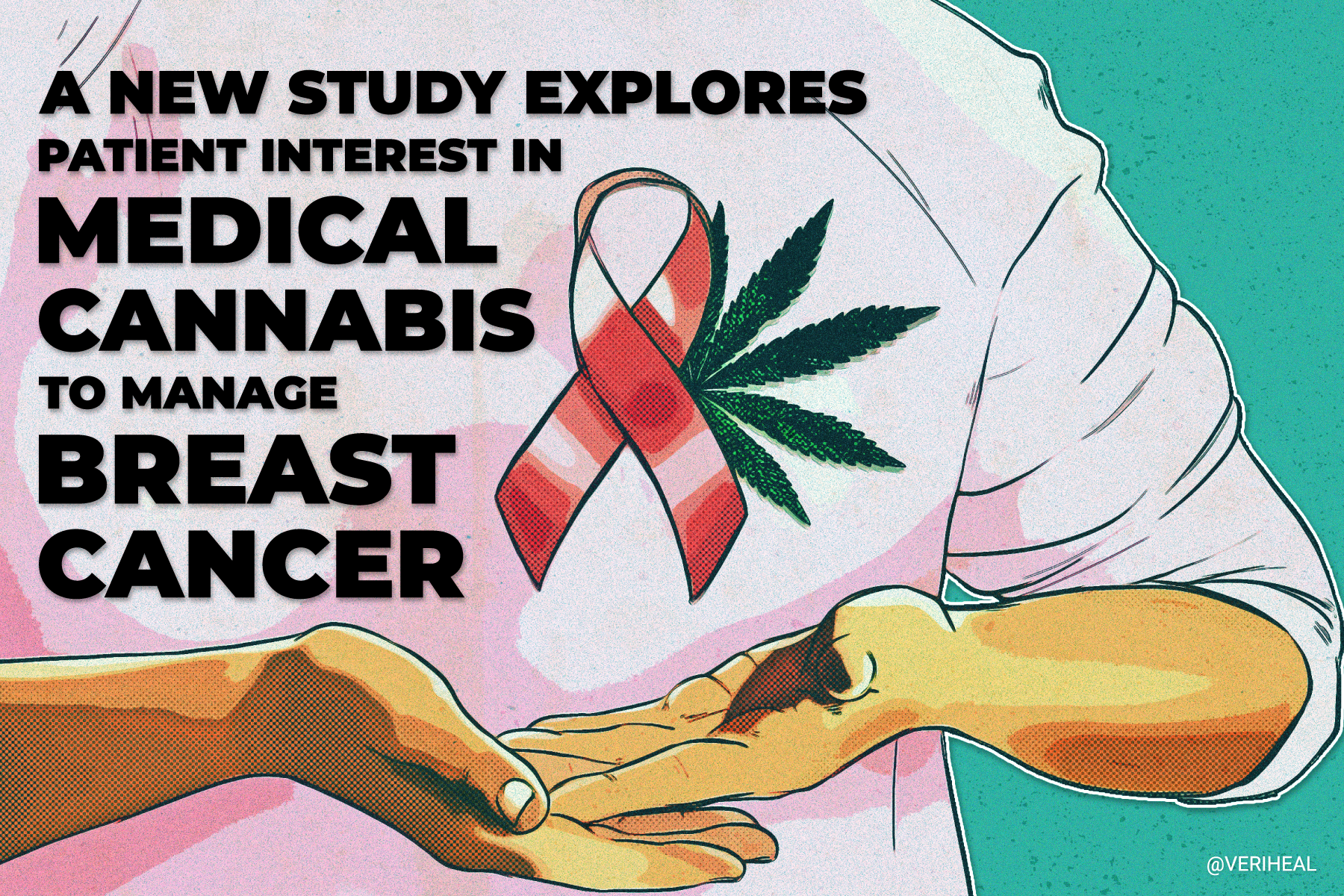Medical Marijuana: Is It an Option for Skin Cancer?

- The Endocannabinoid System of the Skin
- How Does Medical Cannabis Attack Skin Cancer
- What the Science Says About Cannabinoids and Skin Cancer
- Thoughts Regarding Skin Cancer
- Types of Skin Cancer
- Tips for Preventing Skin Cancer
Skin cancer is a complicated thing: sometimes it causes pain and irritation that leads patients to seek out medical advice, while other patients may not even see worrisome skin changes. It is always important to get yearly skin checks and see a medical provider if you notice skin changes in order to make sure it is not skin cancer as it can easily be overlooked. Some types of skin cancer can be treated more easily than others.
In recent years, there has been a lot of research supporting the use of medical cannabis for patients with cancer to help relieve the side effects of cancer and cancer-related treatments. Thankfully there has also been a lot of preclinical and lab research in dermatology that focuses on skin cancer and the potential uses of medical cannabis (31) (21). Human studies are still sorely lacking and are much needed in respect to skin cancers and cannabis.
The cannabis plant’s ability to provide medicinal benefits to our body begins with the activation of the endocannabinoid system (ECS). When cannabinoids found in cannabis, such as Δ9-tetrahydrocannabinol (THC) and cannabidiol (CBD), enter the body through the mouth, digestive tract, skin, or lungs they activate the ECS. The ECS is a system of fat-based neurotransmitters that play a variety of roles in our bodies. Endocannabinoids including anandamide (AEA) and 2-arachidonoylglycerol (2-AG) can be increased or decreased through the activation of receptors including cannabinoid receptors CB1 and CB2. These changes in endocannabinoid levels are important for several processes in our body including modulating the immune system to decrease inflammation, helping our body maintain homeostasis or proper body temperature, and influencing how we perceive chronic pain.
The Endocannabinoid System of the Skin
Clinical trials involving the skin and medical cannabis show that the skin is a very strong target for cannabinoid therapies. Both cannabinoid receptors and endocannabinoids can be found in skin cells called keratinocytes (that produce keratin) and melanocytes (that produce pigment or melanin) in the top layer of the skin (13). Sweat & oil-producing glands, nerve fibers, and hair follicles in the skin also contain larger amounts of cannabinoid receptors (3) (43).
Cannabinoids can also target transient receptor potential (TRP) receptors in skin cells in order to help maintain a healthy skin barrier and reduce inflammation of the skin (3). Peroxisome-activated receptors (PPAR) which help with the expression of genes, including in the skin, are also able to be activated by cannabis and play a role in skin maintenance.
How Does Medical Cannabis Attack Skin Cancer?
Medical cannabis and its cannabinoids have been researched regarding its use in a variety of different types of skin cancer. According to researchers, the cells of both melanoma and non-melanoma skin cancers express both CB1 and CB2 receptors (13). This expression is what allows researchers to utilize the ECS as a target for cancers of the skin. Research has determined that cannabinoids are able to interfere with the migration of cancerous endothelial or skin cells, inhibit their growth, impair blood supply to these cells, and cause the cancer-infected cells to die. This all occurs without damaging normal skin cells.
When it comes to cancerous and noncancerous (benign) skin tumors, researchers believe that CB2 receptors play more of a role in the antitumor effect of cannabinoids than CB1 receptors (13). In addition to CB2 receptors, G protein-coupled receptors, vascular endothelial growth factors, and vascular endothelial ligands play a role in healing cancer-infected skin cells (20).
Medical Cannabis and Treating Cancer
There is a lot of research on using medical cannabis for cancer patients. Many cancer patients undergo chemotherapy or radiation therapy as part of their treatments. Medical cannabis is used in order to control pain, nausea & vomiting, stimulate the appetite, and for mood support for patients during treatment (7). Please check out our main cancer page for more information about how it can help reduce these symptoms.
What the Science Says About Cannabinoids and Skin Cancer
One study focused on Kaposi’s sarcoma (KS) tumor cells that were extracted from KS patients. The researchers were able to trigger apoptosis or cell death in the cancer cell samples using WIN-55, 212-2, which activates both CB1 and CB2 receptors in the cells (18). Simply put, these researchers were able to cause the cancer cells to die, which slowed the spread of KS tumors. They found that in the tested compounds that slowed the production of endocannabinoids, the cancer cells were able to increase their survival. Though this study did not focus on living subjects, the results are promising and show us that cannabinoids have the potential to target cancer cell growth.
Another study focusing on KS also found similar results in that CBD was able to induce cell death in KS cells extracted from patients. These patients had cases of KS that were caused by human herpesvirus 8, which is the underlying cause of KS (20). The CBD tested did not inhibit cancer’s initial efficiency of infecting endothelial cells, a type of skin cell. however, it was able to slow the spreading of KS and induced cell death in cells infected with the cancer-causing virus. This is important because when cancerous viruses infect cells in the body, the cells irreversibly change and are often unable to perform normal functions such as dying. When the cells die, they are unable to keep creating cancerous cells.
Both these studies are very important regarding the treatment of KS, especially in those patients who experience KS as a result of herpesvirus 8 and are immunocompromised. Conventional treatments can inhibit the tumor growth in this type of KS but have so far been unable to eliminate it from the host as herpesvirus 8 complicates the treatment process (20).
The ability of cannabinoids to target skin cancer tumors as found in the studies has been shown to be the case for melanoma and non-melanoma types of skin cancer (13). Please check out our references below if you are interested in reading more about your specific type of skin cancer and antitumor research.
Thoughts Regarding Skin Cancer
It is very important to see a dermatologist or a doctor who is well versed in skin conditions if you suspect you may have abnormal skin growths. These providers may be able to diagnose it by simply looking at it and can take a biopsy to be analyzed in a lab.
Additionally, medical cannabis may not be a good fit for patients with existing heart issues or patients who are taking medications for epilepsy. Veriheal does not suggest forgoing traditional treatments for skin cancer or only utilizing medical cannabis for treatments. Though there is a lot of research suggesting that skin cancer tumors are affected by cannabinoids, much of this research occurs in animals or in cancerous cells that have been extracted from people.
We also do not advise seeking medical treatments from the internet. A recent study published in JMIR Dermatology advises that patients do not use social media and YouTube videos on how to use medical cannabis and other cannabinoids for the treatment of skin cancer. This study examined the top 10 videos for cannabinoids and skin cancer and found that they received scores reflecting that the quality of content presented was poor and they shared unreliable information despite getting upwards of 48% of favorable user ratings (19).
If you do decide with the help of your oncologist or dermatologist to utilize cannabis topicals or CBD products for your skin, it is important to research the products you should purchase beforehand. Please check out our CBD guide for more information on how to make sure you are using safe products.
Types of Skin Cancer
There are several different types of skin cancer and they can sometimes have similar appearances to skin conditions that are non-cancerous or benign. It is important to always reach out to your general doctor or dermatologist if you notice unexplainable skin changes as they can fully evaluate your risks of skin cancer. Treatment may require biopsy, surgery, liquid nitrogen sprays, or the use of anticancer creams. Keep reading to learn about some of the types of skin cancer, as this list does not contain all the possible types.
Basal Cell Carcinoma (BCC)
BCC is the most common type of skin cancer and usually develops in people with fair skin (38). It looks like a flesh-colored, pearl-like bump or some sometimes appear as a pink patch of skin. It is commonly found on the head, neck, and arms, but it can grow on other parts of the body. Diagnosing BCC early is key as it can grow deep into the skin. If they are left undiagnosed, they can penetrate the bones and nerves which can lead to advanced cancer, damage, and disfigurement.
Squamous Cell Carcinoma (SCC)
This cancer is the second most common type of skin cancer and most commonly develops in people with fair skin, though it can appear in patients with darker skin (38). SCC forms on skin that is frequently exposed to the sun such as on the face, back, chest, arms, neck, and upper rim of the ear. These cancerous growths look like a firm red bump, a scaly patch of skin, or a sore that doesn’t heal and reopens. Like BCC, SCC can grow deeper in the skin and cause further cancer spread, damage, or disfigurement.
Actinic keratoses (AKs) are dry, scaly patches of skin that are considered precancerous (38). These growths can turn into squamous cell carcinoma but are generally treatable when caught early.
Melanoma
Melanoma is considered the most severe and aggressive form of skin cancer because it has a strong tendency to spread to other parts of the body. Melanoma cells can develop within a mole that you already had on your skin or it can appear suddenly as a mole-like dark spot on the skin (38). It may even form hidden under the scalp or the back of the eye, emphasizing the need for yearly eye exams and skin checks. These dark spots do not usually have smooth borders around them which is one sign for diagnosing melanoma, among other signs also called the ABCDE’s of melanoma. Early diagnosis and treatment are crucial as melanoma can quickly and aggressively spread to the lymph nodes and other portions of the body.
Please see a doctor or dermatologist right away if you notice an irregularly shaped mole or if an existing mole starts bleeding without injury. It may be a sign of melanoma.
Merkel Cell Carcinoma (MCC)
MCC is a rare type of skin cancer that happens when Merkel cells in the skin start to grow out of control (44). Merkel cells have both the features of hormone-making cells and nerve cells and can be found in the top layer of skin called the epidermis. They tend to be found close to nerve endings in the skin.
This type of skin cancer can grow and spread quickly and is difficult to treat if it spreads beyond the skin. MCC is found mostly on parts of the skin exposed to the sun such as the face, neck, and arms (44). The tumors appear as firm pink, red, or purple lumps or bumps on the skin. MCC can also be called neuroendocrine carcinoma of the skin or trabecular carcinoma.
Cutaneous T-cell Lymphoma (CTCL)
CTCL is not technically a type of skin cancer but is a type of lymphoma or blood cancer instead (34). CTCL begins in a T-lymphocyte cell, which is a common type of white blood cell in the body. Most of these cells can be found in our skin as the skin serves as the first line of defense against infections. Though this type of lymphoma is rare, it often makes appearances on the skin. It appears as red, swollen skin or rashy patches of skin. Because of this, early stages can often be mixed diagnosed as eczema or psoriasis. It often appears on skin that gets little sunlight. Diagnosis and management of CTCL first requires a confirmatory biopsy by specialists.
Dermatofibrosarcoma Protuberans (DFSP)
DFSP is a rare type of skin cancer that begins in the middle layer of the skin called the dermis (35) and grows slowly. It rarely spreads to other parts of the body, but it can grow deep into the fat, muscle, and even bone if it is not addressed, making treatment of the tumor much more difficult. It appears on the skin as a rough patch, scar, or look like a pimple. Doctors do not currently know what causes DFSP or its benign look-alike called dermatofibroma.
Sebaceous Carcinoma (SC)
SC is also known as sebaceous gland carcinoma and sebaceous gland adenocarcinoma. It is considered a rare, but aggressive type of cancer that can be treated if it is found early (36). Most cases of SC begin on the upper or lower eyelid as a painless, round, and firmly implanted growth. When it begins on the eyelid it is called meibomian gland carcinoma. This cancer can also appear on other areas of the skin as we have sebaceous oil and sweat glands all over our bodies.
Kaposi Sarcoma (KS)
Kaposi Sarcoma is a type of cancer that develops in immunocompromised people stemming from a human herpesvirus 8 infection within the cells that line the lymph system or blood vessels (40). Signs of this type of cancer usually show up on the skin or on mucosal surfaces such as in the mouth, but the tumors may also grow on the lymph nodes, lungs, or in the digestive tract. When it appears on the skin, KS forms purple, red, or brown blotches or tumors. These spots are typically referred to as lesions and are most common on the legs or face.
KS has four different subtypes and can be related to the following immunocompromising factors (40):
- HIV/AIDs
- Herpes simplex viruses
- Recent organ transplants
- Mediterranean, Eastern European, and Middle Eastern descent
- Living in areas in Africa that are close to the equator
Tips for Preventing Skin Cancer
Unfortunately, most types of skin cancer are caused by exposure to ultraviolet (UV) light from the sun, tanning beds, and sunlamps (10). Skin cancers typically affect caucasian people more than others and can also be strongly linked to genetic factors. When linked to genetic factors, skin cancers tend to appear in greater numbers at a relatively younger age.
You can lower your risk of developing skin cancer by protecting your skin from the skin, including on cloudy days when the sun does not appear to be out because UV light can reflect off surfaces like water, cement, sand, and snow.
Additional tips for preventing skin cancer include (10):
- Stay in the shade when outdoors
- Wear proven, sun-protective clothing that covers your arms and legs (i.e. SPF-rated sun shirts, activewear, and swimwear)
- Wear a wide-brimmed had to shade your face, ears, head, and neck
- Wear sunglasses that have been rated to block both UVA and UVB light
- Use a broad-spectrum sunscreen with a sun protection factor (SPF) of 15 or higher
- Reapply sunscreen after sweating or entering the water
- Avoid indoor tanning
Note: Veriheal does not intend to give this as professional medical advice. Do not attempt to self-diagnose or prescribe treatment based on the information provided on this page. Always consult a physician before making any decision on the treatment of a medical condition.
1. Adusumilli, N. C., Hazuka, E. L., & Friedman, A. J. (2021). Nanotechnology to deliver cannabinoids in dermatology. Precision Nanomedicine. https://www.researchgate.net/publication/352200710_Nanotechnology_to_deliver_cannabinoids_in_dermatology
2. Bachari, A., Piva, T. J., Salami, S. A., Jamshidi, N., & Mantri, N. (2020). Roles of Cannabinoids in Melanoma: Evidence from In Vivo Studies. International journal of molecular sciences, 21(17), 6040. https://www.ncbi.nlm.nih.gov/pmc/articles/PMC7503316/
3. Baswan, S. M., Klosner, A. E., Glynn, K., Rajgopal, A., Malik, K., Yim, S., & Stern, N. (2020). Therapeutic Potential of Cannabidiol (CBD) for Skin Health and Disorders. Clinical, cosmetic and investigational dermatology, 13, 927–942. https://www.ncbi.nlm.nih.gov/pmc/articles/PMC7736837/
4. Bifulco, M., Laezza, C., Pisanti, S., & Gazzerro, P. (2006). Cannabinoids and cancer: Pros and cons of an antitumour strategy. British Journal of Pharmacology, 148(2), 123–135. https://bpspubs.onlinelibrary.wiley.com/doi/full/10.1038/sj.bjp.0706632
5. Blázquez, C., Carracedo, A., Barrado, L., José Real, P., Luis Fernández‐Luna, J., Velasco, G., Malumbres, M., Guzmán, M., Blázquez, C., Carracedo, A., Barrado, L., José Real, P., Luis Fernández‐Luna, J., Velasco, G., Malumbres, M., & Guzmán, M. (2006). Cannabinoid receptors as novel targets for the treatment of melanoma. The FASEB Journal, 20(14), 2633–2635. https://faseb.onlinelibrary.wiley.com/doi/10.1096/fj.06-6638fje
6. Braun, I. M., Blonquist, T. M., Campbell, E. G., Nayak, M. M., Bolcic-Jankovic, D., & Wright, A. A. (2019). Medical oncologists’ views on the utility of medical marijuana across the cancer trajectory. Journal of Pain and Symptom Management, 57(6). https://www.jpsmjournal.com/article/S0885-3924(19)30051-X/fulltext
7. Cannabis and Cannabinoids (pdq®)–patient version. (2021, March 26). Retrieved May 10, 2021, from https://www.cancer.gov/about-cancer/treatment/cam/patient/cannabis-pdq#link/_76
8. Cannabis and cannabinoids (PDQ®)–health professional version. National Cancer Institute. (n.d.). Retrieved January 10, 2022, from https://www.cancer.gov/about-cancer/treatment/cam/hp/cannabis-pdq
9. Casanova, M. L., Blázquez, C., Martínez-Palacio, J., Villanueva, C., Fernández-Aceñero, M. J., Huffman, J. W., Jorcano, J. L., & Guzmán, M. (2003). Inhibition of skin tumor growth and angiogenesis in vivo by activation of cannabinoid receptors. The Journal of clinical investigation, 111(1), 43–50. https://www.ncbi.nlm.nih.gov/pmc/articles/PMC151833/
10. Centers for Disease Control and Prevention. (2021, April 28). What can I do to reduce my risk of skin cancer? Centers for Disease Control and Prevention. Retrieved January 10, 2022, from https://www.cdc.gov/cancer/skin/basic_info/prevention.htm
11. Cintosun, A., Lara-Corrales, I. & Pope, E. Mechanisms of Cannabinoids and Potential Applicability to Skin Diseases. Clin Drug Investig 40, 293–304 (2020). https://link.springer.com/article/10.1007/s40261-020-00894-7
12. Cridge, B. J., & Rosengren, R. J. (2013). Critical appraisal of the potential use of cannabinoids in cancer management. Cancer management and research, 5, 301–313. https://www.ncbi.nlm.nih.gov/pmc/articles/PMC3770515/
13. Eagleston, L. R., Kalani, N. K., Patel, R. R., Flaten, H. K., Dunnick, C. A., & Dellavalle, R. P. (2018). Cannabinoids in dermatology: A scoping review. Dermatology Online Journal, 24(6). https://escholarship.org/uc/item/7pn8c0sb
14. Glodde, N., Jakobs, M., Bald, T., Tüting, T., & Gaffal, E. (2015). Differential role of cannabinoids in the pathogenesis of Skin cancer. Life Sciences, 138, 35–40. https://www.sciencedirect.com/science/article/abs/pii/S0024320515002209?via%3Dihub
15. Gupta, A. K., & Talukder, M. (2021). Cannabinoids for skin diseases and hair regrowth. Journal of Cosmetic Dermatology, 20(9), 2703–2711. https://onlinelibrary.wiley.com/doi/10.1111/jocd.14352
16. Ladin, D. A., Soliman, E., Griffin, L. T., & Van Dross, R. (2016). Preclinical and clinical assessment of cannabinoids as anti-cancer agents. Frontiers in Pharmacology, 7. https://www.frontiersin.org/articles/10.3389/fphar.2016.00361/full
17. Lim, M., & Kirchhof, M. G. (2019). Dermatology-Related Uses of Medical Cannabis Promoted by Dispensaries in Canada, Europe, and the United States. Journal of cutaneous medicine and surgery, 23(2), 178–184. https://pubmed.ncbi.nlm.nih.gov/30380925/
18. Luca, T., Di Benedetto, G., Scuderi, M. R., Palumbo, M., Clementi, S., Bernardini, R., & Cantarella, G. (2009). The CB1/CB2 receptor agonist WIN-55,212-2 reduces viability of human Kaposi’s sarcoma cells in vitro. European journal of pharmacology, 616(1-3), 16–21. https://pubmed.ncbi.nlm.nih.gov/19539619/
19. Mamo, A., Szeto, M. D., Mirhossaini, R., Fortugno, A., & Dellavalle, R. P. (2021). Tetrahydrocannabinol and skin cancer: Analysis of YouTube videos. JMIR Dermatology, 4(1). https://derma.jmir.org/2021/1/e26564
20. Maor Y, Yu J, Kuzontkoski PM, Dezube BJ, Zhang X, Groopman JE. Cannabidiol inhibits growth and induces programmed cell death in Kaposi Sarcoma-associated Herpesvirus-infected endothelium. Genes Cancer. 2012;3(7-8):512-520. https://www.ncbi.nlm.nih.gov/pmc/articles/PMC3527984/
21. Marks, D. H., & Friedman, A. (2018). The Therapeutic Potential of Cannabinoids in Dermatology. Skin therapy letter, 23(6), 1–5. https://www.skintherapyletter.com/dermatology/cannabinoids-potential/
22. Marzęda, P., Drozd, M., Wróblewska-Łuczka, P. et al. Cannabinoids and their derivatives in struggle against melanoma. Pharmacol. Rep 73, 1485–1496 (2021). https://link.springer.com/article/10.1007/s43440-021-00308-1
23. Merhavi-Shoham, E., Itzhaki, O., Markel, G., Schachter, J., & Besser, M. J. (2017). Adoptive Cell Therapy for Metastatic Melanoma. Cancer journal (Sudbury, Mass.), 23(1), 48–53. https://pubmed.ncbi.nlm.nih.gov/28114254/
24. Milando, R., & Friedman, A. (2018). Cannabinoids: Potential role in inflammatory and neoplastic skin diseases. American Journal of Clinical Dermatology, 20(2), 167–180. https://static1.squarespace.com/static/5dab51c52920995e635d4295/t/5e4bbe406ddc335ff28de578/1582022212575/Milando2019AmJClinDermatol.pdf
25. Nakajima, J., Nakae, D., & Yasukawa, K. (2013). Structure-dependent inhibitory effects of synthetic cannabinoids against 12-O-tetradecanoylphorbol-13-acetate-induced inflammation and skin tumour promotion in mice. Journal of Pharmacy and Pharmacology, 65(8), 1223–1230. https://academic.oup.com/jpp/article/65/8/1223/6132910?login=true
26. Nickles, M. A., & Lio, P. A. (2020). Cannabinoids in dermatology: Hope or hype? Cannabis and Cannabinoid Research, 5(4), 279–282. https://www.liebertpub.com/doi/full/10.1089/can.2019.0097
27. Nikan, M., Nabavi, S. M., & Manayi, A. (2016). Ligands for cannabinoid receptors, promising anticancer agents. Life Sciences, 146, 124–130. https://www.sciencedirect.com/science/article/abs/pii/S0024320515301521
28. Pagano, C., Navarra, G., Coppola, L., Bifulco, M., & Laezza, C. (2021). Molecular mechanism of cannabinoids in cancer progression. International Journal of Molecular Sciences, 22(7), 3680. https://www.mdpi.com/1422-0067/22/7/3680/htm
29. Scheau, C., Badarau, I. A., Mihai, L.-G., Scheau, A.-E., Costache, D. O., Constantin, C., Calina, D., Caruntu, C., Costache, R. S., & Caruntu, A. (2020). Cannabinoids in the pathophysiology of skin inflammation. Molecules, 25(3), 652. https://www.mdpi.com/1420-3049/25/3/652
30. Simmerman, E., Qin, X., Yu, J. C., & Baban, B. (2019). Cannabinoids as a Potential New and Novel Treatment for Melanoma: A Pilot Study in a Murine Model. The Journal of surgical research, 235, 210–215. https://pubmed.ncbi.nlm.nih.gov/30691796/
31. Sheriff, T., Lin, M. J., Dubin, D., & Khorasani, H. (2020). The potential role of cannabinoids in dermatology. The Journal of dermatological treatment, 31(8), 839–845. https://www.tandfonline.com/doi/full/10.1080/09546634.2019.1675854
32. Skin cancer (including melanoma)-patient version. National Cancer Institute. (n.d.). Retrieved January 10, 2022, from https://www.cancer.gov/types/skin
33. Skin cancer: Skin cancer facts: Common skin cancer types. American Cancer Society. (n.d.). Retrieved January 10, 2022, from https://www.cancer.org/cancer/skin-cancer.html
34. Skin cancer types: Cutaneous T-cell lymphoma overview. American Academy of Dermatology. (n.d.). Retrieved January 10, 2022, from https://www.aad.org/public/diseases/skin-cancer/types/common/ctcl
35. Skin cancer types: Dermatofibrosarcoma protuberans overview. American Academy of Dermatology. (n.d.). Retrieved January 10, 2022, from https://www.aad.org/public/diseases/skin-cancer/types/common/dfsp
36. Skin cancer types: Sebaceous carcinoma overview. American Academy of Dermatology. (n.d.). Retrieved January 10, 2022, from https://www.aad.org/public/diseases/skin-cancer/types/common/sebaceous
37. Tóth, K., Ádám, D., Bíró, T., & Oláh, A. (2019). Cannabinoid signaling in the skin: Therapeutic potential of the “c(ut)annabinoid” system. Molecules, 24(5), 918. https://www.mdpi.com/1420-3049/24/5/918/htm
38. Types of skin cancer. American Academy of Dermatology. (n.d.). Retrieved January 10, 2022, from https://www.aad.org/public/diseases/skin-cancer/types/common
39. Velasco, G., Sánchez, C., & Guzmán, M. (2016). Anticancer mechanisms of cannabinoids. Current oncology (Toronto, Ont.), 23(2), S23–S32. https://www.ncbi.nlm.nih.gov/pmc/articles/PMC4791144/
40. What is kaposi sarcoma? American Cancer Society. (n.d.). Retrieved January 10, 2022, from https://www.cancer.org/cancer/kaposi-sarcoma/about/what-is-kaposi-sarcoma.html
41. What to look for: Abcdes of melanoma. American Academy of Dermatology. (n.d.). Retrieved March 6, 2022, from https://www.aad.org/public/diseases/skin-cancer/find/at-risk/abcdes
42. Zhao, H., Fang, X., Li, H., Zhao, Z., & Yang, J. (2012). Cannabinoid receptor 2 is upregulated in melanoma. Journal of Cancer Research and Therapeutics, 8(4), 549. https://www.cancerjournal.net/article.asp?issn=0973-1482;year=2012;volume=8;issue=4;spage=549;epage=554;aulast=Zhao
43. Kupczyk, P., Reich, A., & Szepietowski, J. C. (2009). Cannabinoid system in the skin – a possible target for future therapies in dermatology. Experimental Dermatology, 18(8), 669–679. https://onlinelibrary.wiley.com/doi/10.1111/j.1600-0625.2009.00923.x
44. What is Merkel cell carcinoma? American Cancer Society. (n.d.). Retrieved March 6, 2022, from https://www.cancer.org/cancer/merkel-cell-skin-cancer/about/what-is-merkel-cell-carcinoma.html








